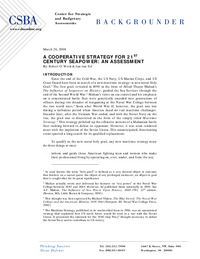
Since the end of the Cold War, the US Navy, US Marine Corps, and US Coast Guard have been in search of a new maritime strategy—a new naval Holy Grail. The first grail, revealed in 1890 in the form of Alfred Thayer Mahan’s The Influence of Seapower on History, guided the Sea Services through the end of the Second World War. Mahan’s views on sea control and his emphasis on a concentrated battle fleet were genetically encoded into generations of officers during two decades of wargaming at the Naval War College between the two world wars. Soon after World War II, however, the grail was lost during a turbulent period when America faced no real maritime challenger.
Decades later, after the Vietnam War ended, and with the Soviet Navy on the rise, the grail was re-discovered in the form of the simply titled Maritime Strategy. This strategy polished up the offensive notions of a Mahanian battle fleet rushing forward to defeat its opponent. However, it was soon rendered moot with the implosion of the Soviet Union. This unanticipated, disorienting event spurred a long search for its qualified replacement.
To qualify as the new naval holy grail, any new maritime strategy must do three things at once:
- inform and guide those American fighting men and women who make their professional living by operating on, over, under, and from the sea;
- be welcomed by US political leaders and representatives of the American people who will then seek and approve the funds necessary to implement the three Sea Services’ strategy (above those that might otherwise be expected); and
- be accepted, if not outright applauded and supported, by US naval allies.

























